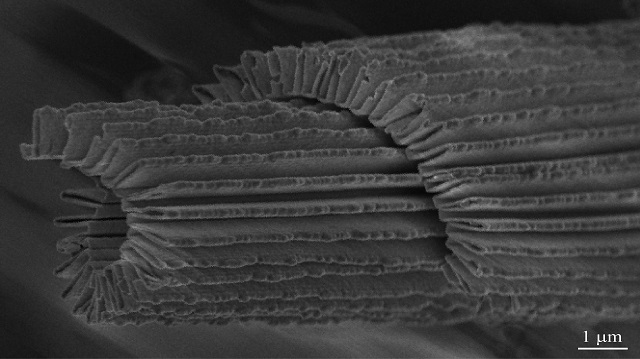 The dimensions of each ridge directly affect the transparent conductor’s stretchability (Credit: Abhijeet Bagal)
The dimensions of each ridge directly affect the transparent conductor’s stretchability (Credit: Abhijeet Bagal)
North Carolina State University researchers have developed flexible, transparent conductors with “nano-accordion” design. The conductors hold promise in different applications including wearable sensors, stretchable displays or flexible electronics.
“There are no conductive, transparent and stretchable materials in nature, so we had to create one. Our technique uses geometry to stretch brittle materials, which is inspired by springs that we see in everyday life. The only thing different is that we made it much smaller.
Abhijeet Bagal, a Ph.D. student in mechanical and aerospace engineering at NC State
The researchers first produced a 3D polymer template on a silicon substrate. The shape of the template was similar to a sequence of like and uniformly spaced rectangles which are covered with an aluminum-doped zinc oxide conducting material. The zinc oxide material is applied with an elastic polymer. The researchers later inverted the whole structure and removed the silicon and the template.
A set of symmetrical, zinc oxide ridges was left behind over an elastic substrate. The transparency of the structure was due to the presence of clear polymer and zinc oxide. The ridges of zinc oxide, which enable expansion and contraction of the structure like the bellows of an accordion contributes to the stretchability of the structure.
We can also control the thickness of the zinc oxide layer, and have done extensive testing with layers ranging from 30 to 70 nanometers thick. This is important because the thickness of the zinc oxide affects the structure’s optical, electrical and mechanical properties.
Erinn Dandley, a Ph.D. student in chemical and biomolecular engineering at NC State and co-author of the paper.
The structure’s stretchability can be directly influenced by the ridge dimensions. Therefore, the 3D templates involved in the study were accurately engineered with the help of nanolithography. The taller ridge makes the structure more stretchable. This is due to the expansion of the structure as the sides of the ridge bend away from each other at the base, which resembles a person performing a split.

The dimensions of each ridge directly affect the transparent conductor’s stretchability. Image: Abhijeet Bagal. Click to enlarge.
The structure can be expanded for a number of times without causing damage. Although there is certain conductivity loss that occurs during the stretch of the nano-accordion, conductivity is not gets affected by the additional stretching.
The most interesting thing for us is that this approach combines engineering with a touch of surface chemistry to precisely control the nano-accordion’s geometry, composition and, ultimately, its overall material properties. We’re now working on ways to improve the conductivity of the nano-accordion structures. And at some point we want to find a way to scale up the process.
Chih-Hao Chang, an assistant professor of mechanical and aerospace engineering at NC State and corresponding author of the paper
The researchers are also working on the use of other conductive materials to produce non-transparent, elastic conductors.
The research paper titled “Multifunctional Nano-Accordion Structures for Stretchable Transparent Conductors,” was published in the Materials Horizons journal. The co-authors of the paper include Erinn Dandley, Junjie Zhao, Xu Zhang, Christopher Oldham and Gregory Parsons of NC State. The research was supported by NASA under grant number NNX12AQ46G.
Transparent, Stretchable Conductors Using Nano-Accordion Structure
References